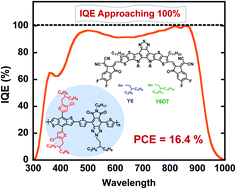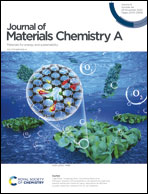Tailoring the side chain of imide-functional benzotriazole based polymers to achieve internal quantum efficiency approaching 100%†
Abstract
The development of halogenated organic semiconducting materials has triggered a significant enhancement in power conversion efficiency of organic solar cells. Herein, two wide-bandgap polymers containing an electron-deficient [1,2,3]triazolo[4,5-f]isoindole-5,7(2H,6H)-dione (TzBI) unit were developed, by introducing a halogen atom into the thienyl side chain of the copolymerized benzo[1,2-b:4,5-b′]dithiophene unit. When combined with a non-fullerene acceptor Y6, both copolymers presented increased crystalline coherence length and significantly reduced phase-separated domain size, thus resulting in higher charge transfer efficiency and more satisfactory charge transport properties than the non-halogenated polymer analogue PHT-EHp without halogen substituents in the thienyl unit of the side-chain. The organic solar cell device based on the PClT-EHp:Y6 blend presents a remarkable current density of 27.3 mA cm−2 and an impressively high internal quantum efficiency approaching 100% at the wavelength of 820 nm, both of which are among the highest values reported for single-junction organic solar cells. Moreover, the devices prepared from PClT-EHp and the Y6-derivative, Y6DT, present a further enhanced efficiency of 16.4%, demonstrating the efficacy of delicate materials design toward high-performance binary organic solar cells.



 Please wait while we load your content...
Please wait while we load your content...